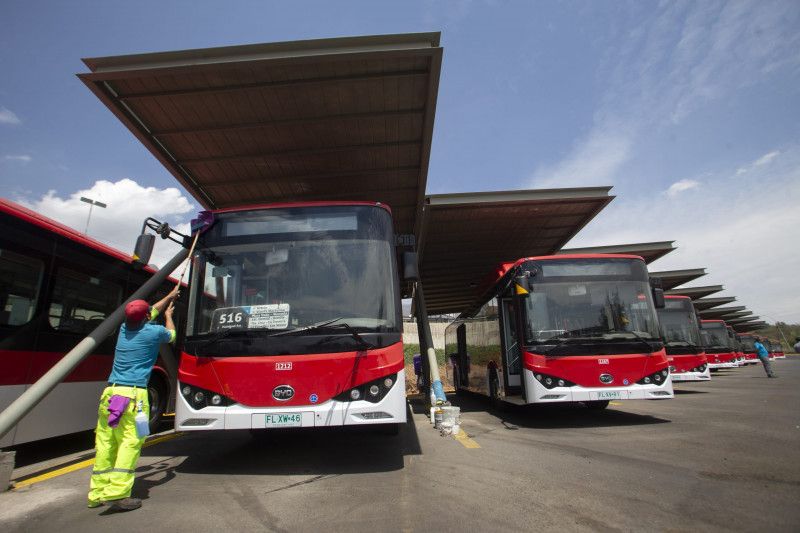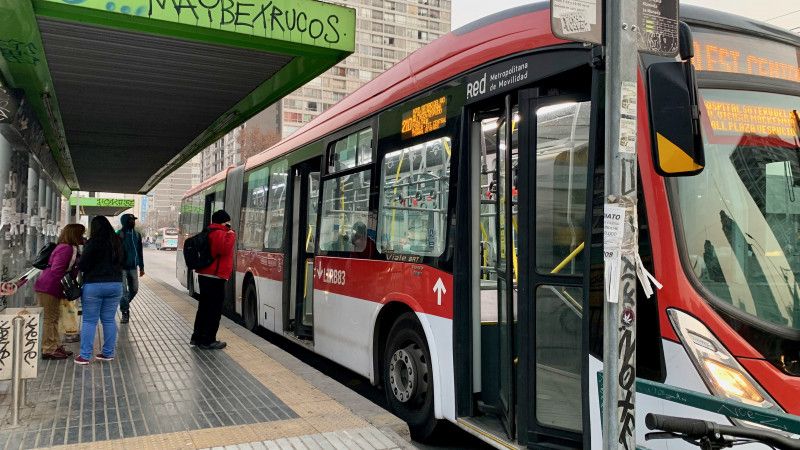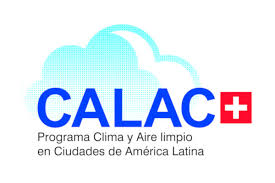Using Artificial Intelligence to evaluate the environmental impact of electric or diesel buses in public transport in Santiago de Chile
Latin America has a very large vehicular fleet and in the last 10 years most of the countries have increased their transportation rates by 4.7%, on average. Since the vast majority of vehicles run on fossil fuels, if this is not controlled it will become an important factor contributing to pollution and environmental degradation for the whole planet.
Because of this, it is very important to work towards a sustainable transport system (non-motorised transport and public transport being the main actors) and work together with urban planning through public policies that promote low-carbon technologies that contribute to a more environmentally friendly world.
CALAC+: a project for clean air in Latin America

In this context, Chile has set public transport replacement targets and expects to have 100% electric bus fleet by 2040. In addition to defining how an electric fleet of public transport is managed in the country, one of the main points to be solved in the transition towards electric bus fleets is to accurately measure the effect of the emissions reduction, establish whether or not they contribute to the mitigation of climate change, and quantify this reduction as well as the economic benefits for society.
To answer these questions, the Climate and Clean Air Programme in Latin American Cities (CALAC+) has carried out a study entitled Life cycle analysis of electric buses in the Santiago public transport system (in Spanish)**, RED for the Ministry of Transport and Telecommunications, Ministry of Energy and Ministry of the Environment of Chile. This research provides significant data that contributes to decision-making in public policies for the promotion of electronic mobility.
The study made use of modern methodologies for
- data acquisition of the buses in operation through remote sensors in the engines, information transfer through General Packet Radio Service (GPRS) and data loggers to record data and send information in real-time using GPRS technology,
- for the proper management of the large amount of data generated and
- for the application of artificial intelligence (AI) algorithms to make predictions about energy consumption.
In this way, it was possible to quantify the environmental impact that a bus fleet would have and evaluate the costs and benefits obtained throughout its life cycle (from cradle to grave).

Why Artificial Intelligence?
The “Deep learning” branch of artificial intelligence was used to work with and process large amounts of operational data from the electric fleets and to be able to predict their consumption throughout their useful life. This form of AI seeks to imitate, through algorithms, the way humans learn through their neural networks.
Since this is based on a concept of neural networks (such as human neurological connections), the algorithms used by Artificial Intelligence understand, train, and predict the behaviour of a variable based on a series of predefined data and criteria.
To predict the energy consumption of electric buses throughout their life, criteria or variables such as brands, weights, distances, speed, among others, were defined; the data was then pre-processed to analyse the relationships between the variables. Thus, it was possible to define the most appropriate algorithm. From simple algorithms, networks are created that will configure a model similar to neural connections. The signals (data) transmitted through a network, activate responses related to the expected purpose (energy consumption). By grouping hundreds of these neurons into networks, it is possible to model behaviour such as the state of charge of the battery in an electric vehicle.
For the case of the study, it was concluded that the algorithm was successful and could predict the state of charge (and, thus, consumption) of the electric buses in Santiago de Chile with 99% accuracy.

Electric buses cause less pollution
With the results of the behaviour of electric fleets, it was possible to complete the information to perform a comparative analysis between fleets of buses equipped with Euro VI diesel technology and those equipped with electronic technology. The impact on the environment of electric buses largely depends on the type of its energy source (whether the electrical energy is generated from renewable or non-renewable sources in terms of global warming).
If the source of the electric supply is 100% renewable (required in the tender contracts for electric buses that circulate in Santiago), in the use phase, emissions decrease to less than a quarter of the emissions of those using diesel technology, resulting in lower polluting emissions throughout its life cycle.
From an economic point of view, even though electric buses have a higher purchase cost, they present lower operating and maintenance costs, resulting in a lower total cost compared to diesel fleets.

Increased efficiency and environmental benefits
The result of this study shows that the electric bus fleets are more energy-efficient and it corroborates the environmental benefits generated by the electric buses that circulate in Santiago. However, it also highlights the need to decarbonise electrical power generation sources to increase the benefits of electronic mobility to mitigate climate change.
This study carried out in coordination with the Ministry of Energy of Chile, the University of Chile, and the Ministry of the Environment of Chile, is a reference for other cities in the region and cities such as Bogotá, Lima and Mexico City are very interested in replicating this experience.
The programme Calac+ has developed various studies, research, tools, seminars and arranged technical visits to various places with the vision of having healthier cities that are able to reduce the emissions of short-lived climate pollutants (such as black carbon), atmospheric gases and greenhouse gases (GHG). They want to achieve this by promoting the shift towards soot-free city buses and low-carbon off-road equipment to produce clean energy.
Calac+ is a pioneer in the region in the use of artificial intelligence to predict behaviors that models energy consumption as well as the generation of pollutants. Because of this, it was possible to carry out a comparative analysis between the electric buses’ technology and the Euro VI diesel technology and determine the environmental impact of both and its costs throughout their life cycles.
**The study was carried out for Calac + by Juan Pablo Romero, Civil Mechanical Engineer and Data Scientist from the University of Chile and Paulina Ramírez Del Barrio, Civil Electrical Engineer and Researcher in Electromobility at the Energy Center of the University of Chile.
